FUE Hair Transplant Surgery
- by Andrew Mackay
- Medical review by Dr. Lawrence Barnard, MD
- Updated:
Follicular unit extraction (FUE) hair transplant involves the transplantation of hair from one area of the body to another. This minimally invasive treatment permanently restores hair in balding or thinning areas.
Losing your hair can be a frustrating and upsetting experience and preventative measures can sometimes feel like a lost cause. This hair transplant procedure aims to eliminate these frustrations by giving you back natural-looking hair.
But, while famous hair transplant cases are becoming more common, jumping into a cosmetic procedure can feel like a daunting thing to do. Knowing how to select the right doctor and clinic, finding a good balance between price and quality, and choosing between treatment abroad or at home, are just some of the hurdles facing prospective FUE hair transplant patients.
We receive a lot of positive feedback from patients undergoing hair transplant treatment in Turkey, Hungary or Poland. But also Germany and Mexico are good options if you do not want to have the procedure done in the United Kingdom.
The content has been reviewed for quality and accuracy to the best of our knowledge by Qunomedical and its Medical Board of Experts.
FUE Hair Transplant Quick Details
WHO IS THIS FOR
Those who are balding or who have thinning hair.
Men and women with a receding hairline.
People who suffer from traction alopecia.
People who’ve lost hair due to a head injury.
TREATMENT DURATION
FUE hair transplants normally take between 4-8 hours.
For FUE hair transplants abroad, plan to be away from home for at least two nights.
RECOVERY TIME
Redness and scabbing should die down after 2-3 weeks.
Return to light routine activities after two days.
Return to the office after three days.
Exercising, including swimming, one month after treatment.
You can wear soft hats and baseball caps after 10 days.
You should wait four weeks before wearing hard hats again.
SUCCESS
Full results are usually visible after 12-18 months.
POTENTIAL RISKS & SIDE EFFECTS
Pain
Bleeding
Infection
Swelling or redness of the scalp/or forehead
Before / After Photos
FUE Hair Transplant Costs
While FUE hair transplant costs have become more affordable in recent years, they can vary depending on a few different factors.
Prices may change based on:
The clinic and doctor you choose.
How many grafts you have transplanted.
Whether or not you need a second transplant.
Whether you choose to get a FUE hair transplant in the UK or abroad.
Quno Price
Below, we’ve laid out the starting prices for FUE hair transplants at Qunomedical-approved clinics. These are based on the price for 2,000 grafts. However, they're not fixed or guaranteed and may vary from patient to patient, depending on a variety of different factors.
| Country | Price (EUR €) |
|---|---|
| Turkey | €2,200 |
| Poland | €2,700 |
| Hungary | €3,100 |
| Germany | €3,000 |
| Spain | €3,200 |
| Thailand | €3,600 |
| Mexico | €3,800 |
| USA | €4,960 |
| United Kingdom | €5,000 |
| Ireland | €10,500 |
Price Calculation
As previously mentioned, calculations for the overall price of this treatment are dependent on a number of different factors. When you, together with your Patient Manager, make an inquiry about FUE hair transplant surgery, your price quote will be based on a few different criteria.
Price per Graft
Flat Rate for Specific Number of Grafts
Flat Rate for Maximum Number of Grafts
Transplantation Method
Location
Prescriptions
FUE Hair Transplants: How Do They Work?
A FUE hair transplant is a pretty simple procedure, but what actually happens during your surgery? Simply put, a hair transplant moves hair from one part of your body to another. Hair follicles grow in groups of 1-4 hairs, known commonly as grafts. These grafts are taken from your donor area, that’s the part of your body — typically the back of your head — with hairs that aren’t susceptible to patterned hair loss. These hairs are then transplanted into your recipient area, that’s the bald or thinning part. The hair grafts that are taken from your donor area are resistant to a hormone that is thought to cause hair loss. When your surgeon transplants these grafts to the recipient area, they retain the resistance to this hormone and are therefore permanent.
During a FUE hair transplant, a surgeon will typically transplant anywhere between 500 and 5,000 grafts. Significant success rates, reduced costs, and longer-lasting results have brought this treatment into the forefront of the plastic surgery world, with it now being considered one of the highest-quality procedures available.
Getting Ready for Your FUE Hair Transplant Surgery
No two hair restoration surgeries are ever identical. Yours will be specifically planned out based on your individual needs, preferences and chosen clinic and doctor. However, there are a few main steps that are involved in the run-up to all FUE hair transplants. These include:
An initial consultation
Planning your visit to the clinic
On-site consultation with your doctor
A few initial checks and tests
Preparing for surgery
These steps will allow your chosen doctor to understand the underlying reasons behind your hair loss, to ensure that the treatment is carried out in the best possible way.
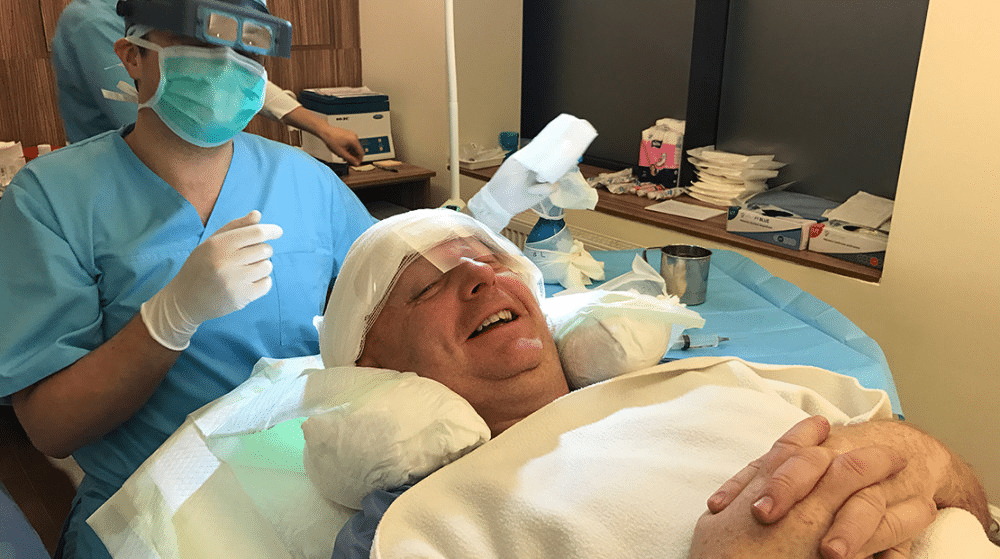
FUE Hair Transplant Surgery: Step-by-Step
You’re now through the preparation stage and are ready for your FUE hair transplant. Once you feel happy to proceed, your treatment team will begin your hair restoration procedure.
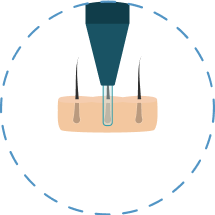
Step 1
Punch incisions around hair follicles
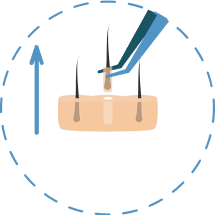
Step 2
Extraction of follicular units

Step 3
Harvesting of the grafts
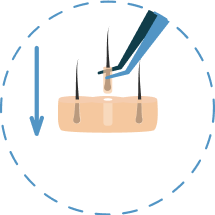
Step 4
Implantation of the grafts
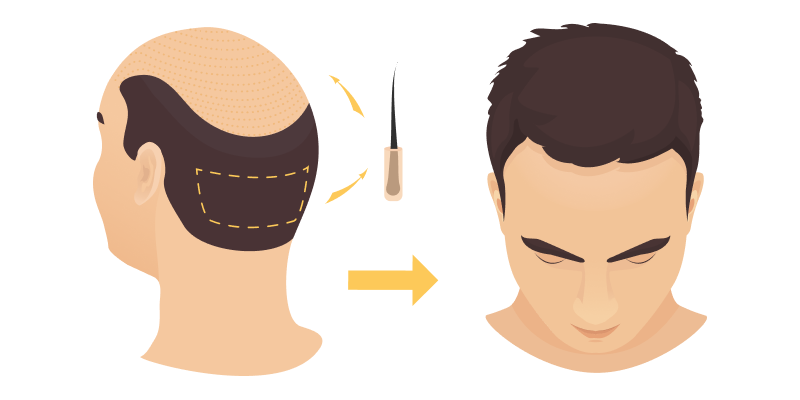
1. Extracting the Grafts
A local anaesthetic is administered to numb your head for the duration of the surgery. Hair grafts are extracted one at a time and sorted in single, double, and triple hairs. They're then placed in special storage solutions that maintain their vitality.
2. Making the Incisions
Following extraction, microblades are used to create small incisions in which the hair grafts can be placed. These incisions determine the direction of hair growth and so your doctor will angle them in a consistent pattern, to ensure a natural look and density.
3. Implanting the Grafts
The extracted hair grafts are then inserted into the bald or thinning area of your head. This typically takes a few hours and patients often pass the time by reading, watching TV or even taking a nap!
Note: During this stage, it’s common for patients to also receive what’s known as platelet-rich plasma (PRP) treatment. This is often offered as a complementary treatment alongside an FUE hair transplant, as it promotes hair growth and helps with healing after your surgery.
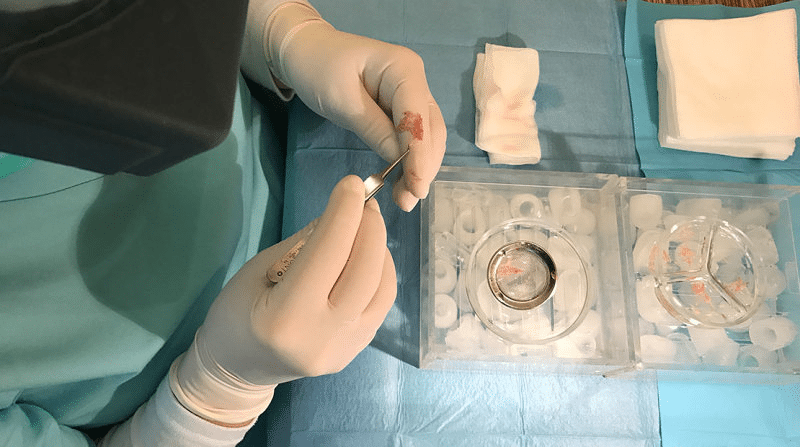
4. Post-Operative Check-Up
After your FUE hair transplant, your treatment team will give you some painkillers to ease any soreness that you may have in the following days. If you’ve chosen to have your FUE hair transplant abroad, you’ll spend the night in accommodation nearby. The day after your treatment, you’ll meet up with your treatment team again for a post-op check-up. During this, your doctor will also give you some advice and instructions to follow in the following weeks.
FUE Hair Transplant Results
Once you’ve had your FUE hair transplant, you should see gradual hair growth on your previously bald or thinning area. For more detailed information, check out our post-op hair transplant guide.
YouTube Video was not loaded due to privacy settings.
Please check your cookie preferences and reload the page.
The First Two Weeks After Treatment
You may find that your head is a little sore and tender during the first couple of weeks following your hair follicle transplant. It’s also likely that you’ll see visible scabbing, but this should gradually improve during the second week. If you notice that some hairs are falling out, don’t panic! This is a completely normal part of the process and these will grow back in the coming months.
Weeks 2-8
It’s likely that you’ll start to experience what’s known as the 'shedding phase'. This is when up to 90% of your transplanted hair, and possibly some of your natural hair close to the donor site, falls out. Again, don’t worry about this! It occurs in 95% of FUE hair transplant cases and it’s a natural, transient reaction to the treatment. Your hair will gradually recover and grow back after this. Some clinics may also advise undergoing platelet-rich plasma (PRP) treatment to improve and stimulate this recovery.
Months 2-6
Your hair growth may be fairly slow between the second and fourth month after your treatment, with typical growth being around 5%. By the fourth month though, you should begin to notice around 20-25% of your new transplanted hair start to grow. By month six, you should see around 40-50% of new hair growth beginning to show.
Months 6-12
Between the sixth and ninth month, your transplanted hair should reach a growth level of around 75%. After the ninth month, your transplanted hair should continue to grow, typically the last 25%. However, it’s worth noting that in some cases it may take up to 18 months after your surgery to fully regain any hair in the crown area of your head.
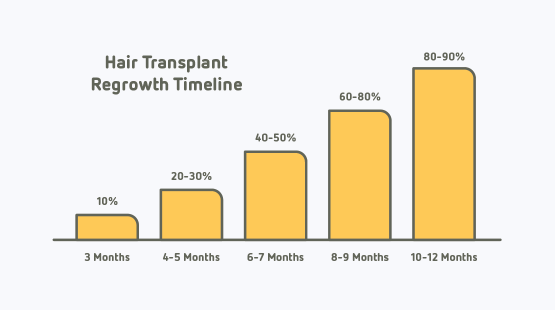
Popular Doctors
Interested in having a look at some of the people involved in the industry? Check out our list of FUE hair transplant doctors which shows some of the most popular choices among our past patients. Read about their medical history, experience, accreditations, and the unique treatment packages that they offer. These doctor profiles can help you decide who is best suited for your treatment. Dr. Mehmet Erdogan, MD for example, is a leading FUE hair transplant surgeon based in Turkey. Dr. Erdogan speaks English and has performed over 2,500 hair transplants since 2011. He’s also co-founder of the well-renowned Smile Hair Clinic, in Istanbul.
Getting a FUE Hair Transplant Abroad and in the UK
Choosing between undergoing a FUE hair transplant in the UK or abroad can be tricky. FUE hair transplant clinics in Turkey for example, are a popular choice for patients, thanks to low prices and high-quality care, but travelling abroad for healthcare can feel daunting for some. But, clinics abroad are experienced in caring for international patients, so travelling for treatment is as straightforward as staying in the UK. That being said, there are still a few common questions that patients have before travelling for a FUE hair transplant abroad.
1. Will My Doctor Speak English?
2. How Do I Get Around in a City That I Don't Know?
3. If I Have Any Questions, Will I Still Be Able to Contact My Doctor When I Get Home?
4. Where Should I Go for My FUE Hair Transplant?
Why Choose Qunomedical?
At Qunomedical, we provide a patient first service. Our team has been built on the passionate belief that healthcare should be easily and readily accessible to all, regardless of background. Whether you’re simply looking for some information about FUE hair transplants, or are ready to find a doctor to book with, we can help!
✔ 100% free, non-binding assessment: Regardless of whether you go on to book a treatment or not, we offer a 100% free, non-binding assessment.
✔ Verified doctors and clinics: Every doctor and clinic that we provide you with information on has been professionally vetted in accordance with our proprietary scoring system, Qunoscore.
✔ All-inclusive packages: Interested in having your FUE hair transplant abroad? Many clinics offer all-inclusive packages which can include hotel accommodation, airport transfers, and taxis to take you to and from the clinic.
✔ 24/7 support: Qunomedical believes strongly in end-to-end care – from your first questions to your successful recovery. Reach your Patient Manager via phone, WhatsApp, Facebook Messenger, or email. In emergency cases, our team can always be reached, 24/7.
✔ Price match: Found a FUE hair transplant at the same clinic, with the same doctor, cheaper somewhere else? We’ll match it.
Still unsure about whether a FUE hair transplant is right for you? Check out Shane’s story below where he talks about his decision to undergo surgery, his experience of booking through Qunomedical, what it was like to travel abroad, as well as some insider tips for future patients.
YouTube Video was not loaded due to privacy settings.
Please check your cookie preferences and reload the page.
FUE Hair Transplant Reviews
FUE Hair Transplant Reviews
4.809.11.2023
(Translated by Google) I can highly recommend Qunomedical, the advice on treatment and individual quotation is great and the friendly customer service team provides excellent advice. I was able to choose the best offer for me. Even after the treatment, the team is still there for you. (Original) I can highly recommend Qunomedical, the advice on treatment and individual quotation is great and the friendly customer service team provides excellent advice. I was able to choose the best offer for me. Even after the treatment, the team is still there for you.
07.09.2023
Ellie was great ,very professional,thanks
05.09.2023
The agent was exceptionally friendly and helpful.
18.08.2023
I was In Istanbul for my Hair Appointment at Memorial Bahçelievler Hospital & the service was so amazing from Doctor ATILLA ADNAN & Doctor SEMA AYSAN & All Stuff so Helpful with amazing Service including ( YALCIN - HODAN HASSAN & ASLISHNW - ILAAYDACETIN & Other!! Thank you for your service Definitely l recommend This Hospital!!

Patient manager
Frieda
Your personal Patient Manager
Let's talk
Still unsure? Feeling overwhelmed? Talking to a real person can give you the guidance and reassurance needed. You don’t have to do it alone. Let’s find the right doctor together.

